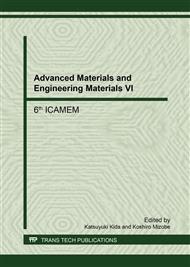p.363
p.369
p.375
p.381
p.386
p.391
p.396
p.403
p.408
Three-Dimensional Scanning Hall Probe Microscopy for Final Stage of Crack Growth of Chromium Molybdenum Steel SCM440
Abstract:
Crack propagation around the stress concentration area causes fatigue failure. Non-destructive method is necessary for monitoring structure fatigue before destruction. We focused on a magnetic non-destructive evaluation method for crack growth. In order to understand the relation between crack propagation and changes in magnetic flux density, we observed the position of the positive and negative magnetic flux density distributions around the crack of tool steel (SCM440) plate using a scanning Hall probe microscope (SHPM). We found that the vertical component of the three-dimensional magnetic flux density moved as the crack growth. Furthermore, the magnetic component which is parallel to the tensile stress appeared just before destruction of the specimen.
Info:
Periodical:
Pages:
386-390
Citation:
Online since:
August 2017
Authors:
Price:
Сopyright:
© 2017 Trans Tech Publications Ltd. All Rights Reserved
Share:
Citation:


